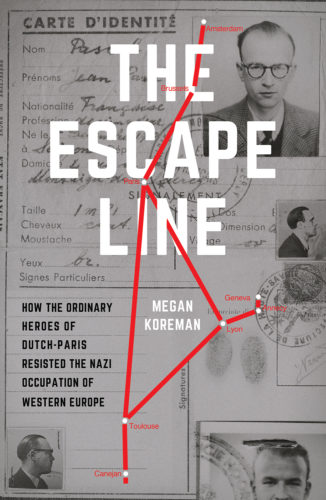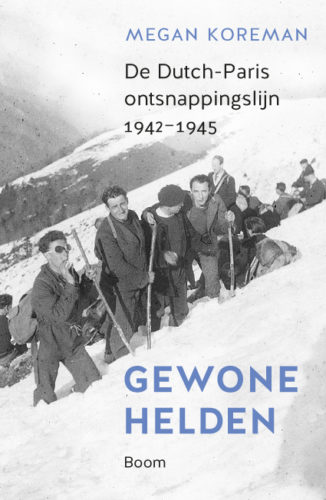Searching for the Dutch-Paris Escape Line
Double Agents
Let’s continue our discussion of the hazards of having to trust strangers for a resistance line. It was possible that the authorities might capture someone the line was helping and get information out of that person. It was also a very real possibility that a German agent might infiltrate an escape line by pretending to be a downed Allied aviator.
But the most serious danger and the one that caused the most damage was the German agents who infiltrated resistance lines by pretending to be resisters. Many of these agents were not themselves German but were French or Belgian or Dutch men or women being paid by the Germans to betray their countrymen and women.
Dutch-Paris itself did not fall victim to Read the rest of this entry »
False Aviators
In the last post we talked about how resisters had to rely on their gut instincts or on referrals to judge whether to trust someone. In the case of an escape line such as Dutch-Paris, they had to trust strangers to work with and to help. But it made any resistance network vulnerable.
The German occupation authorities were very aware of this vulnerability among resisters and especially in escape lines. They exploited it expertly and efficiently to infiltrate the networks.
One of the better known ploys used by German military police was to send false aviators through an escape line. The idea was that a German agent would pretend to be a downed Allied aviator all the way through the line to Spain. In Spain he would Read the rest of this entry »
Vulnerability of an Escape Line
Rescuing people from the Nazis and their ilk was dangerous and illegal work. Everything had to be done clandestinely, which meant that the rescuers had to either trust their gut instinct about working with or helping strangers or they had to go by referral. It’s not like they could advertise in the paper and ask for three letters of recommendation.
This fundamental fact of resistance had several consequences. The most dire was that it made resistance networks vulnerable to the enemy. As an example, the Comité was helping a Jewish man hide in Brussels. The man was able-bodied and willing to risk walking through the streets each month to collect the new ration cards and money that his family would use in hiding for the next month.
But one month he and every other pedestrian on the street walked into a trap. The occupation authorities often cordoned off Read the rest of this entry »
The Hunger Winter
In my last post I mentioned that the Dutch remember the last winter of the war, 1944/45, as the Hunger Winter. In September 1944 the Allies liberated the southern third of the Netherlands but failed to liberate the rest of the country where most of the populace lived. The Allied advance pushed eastward into The Third Reich, leaving most of the Dutch people under the control of angry and fanatical Nazi occupation authorities. In a vicious response to the uncooperative attitude of much of the Dutch populace, the Nazi authorities cut off food supplies to civilians. They barricaded and guarded warehouses.
Civilians made long treks out of the big cities and urban areas by foot and by bicycle to hunt down and barter for food in farming regions. Nevertheless, tens of thousands starved to death. When the Allies arrived in early May 1945 they found most of the population on the verge of starvation.
As desperate as not having enough food or fuel during the coldest winter anyone could remember was, the Dutch people still had to navigate the dangers of Read the rest of this entry »
The Last Bitter Winter of the War
By the time the Second World War ended in Europe in May 1945, most of the urban trees in parks and along streets had been cut down – often illegally – for firewood.
The war years were cold. Every year of rationing made civilians more malnourished and more shabbily dressed. Every winter fuel rations decreased and supplemental sources of heating and cooking fuel, such as trees, disappeared. Each winter was more severe than the last while the people were less able to withstand the cold. But whether they had warm boots or enough food to eat, they had to stand outside in lines for their rations.
Bitter cold marked the last winter of the war, what the Dutch remember sorrowfully as The Hunger Winter for the man-made famine imposed by the Occupier. In liberated Belgium and France the resisters of Dutch-Paris shivered along with the rest of the general population. Except for those of them who had been arrested before the liberation and deported to concentration camps. With scarcely enough food to cling to life and dressed in rags, the Third Reich’s political prisoners labored in the elements and stood for hours in the open, freezing air. They endured beyond the limits of endurance.
But winter does not take sides. Soldiers on both sides of the battle lines froze to death. German women and children stumbled ahead of the rampaging Red Army on frostbitten feet as the Soviets moved through Prussia towards Berlin.
It was war – the product of human machinations – that caused the suffering of millions during that harsh winter of 1944/45. Without the war civilians and soldiers alike would have had the food, clothing, shelter and fuel that humans need to survive great cold. The winter would have been just as harsh, but far less deadly. It’s the human concept of war and the actions humans take to prosecute war that is the enemy.
In a previous post I mentioned the possibility of false resisters making claims to having been in the resistance during the uncertain period of the Liberation. It happened. Not often, but often enough that if you come across someone making claims that no one else in the resistance network verifies, you should treat those claims with caution.
There is, however, another, most honest, reason that a resister’s reports or testimony could be incorrect. Resistance was a highly dangerous, nerve wracking and secretive endeavor. The fewer people who knew something like an address and the fewer people in the network who each person knew, the safer it was for everybody. So resisters were operating on limited information.
But when a network was rounded up, the Gestapo and their colleagues tended to Read the rest of this entry »
Christmas Donuts 1944
There are lots of heart-warming stories about soldiers making their own bit of Christmas during WWII by doing things like dressing up as St. Nick and having parties for the local children.
My favorite is a family story. It didn’t happen exactly on Christmas, but it did happen during the fall and winter of 1944/45.
My father was a toddler when the Germans occupied his hometown of Maastricht. He was seven when the Americans Read the rest of this entry »
Beware of False Claims of Resistance
At the beginning of this discussion about finding Engelandvaarders in the archives, I mentioned that it’s important to get more than one version of any particular event. Obviously that’s true in almost all situations. But let’s think about why it’s important when reading through the documents on resistance.
Keep in mind that most of the documents about resistance were written or recorded in the immediate postwar period. The leader of Dutch-Paris was able to write reports during the war because he went in and out of Switzerland and kept the records in Switzerland. Most resisters would have been taking a terrible risk to write anything down.
Immediately after the liberation of a country, even before the prisoners returned from the Third Reich, resisters started writing down what they had done. More importantly, bureaucracies Read the rest of this entry »
Last time we talked about the arrest of a local Dutch-Paris leader under a false name in Brussels. A very similar thing happened to another Dutch-Paris leader in Paris.
This man, who we’ll call Smit, had been an important leader of Dutch-Paris and other rescue groups in Brussels until the Gestapo got too close. He left Belgium for Paris and set about trying to re-build Dutch-Paris there after the big round-up in February 1944. One of Smit’s contacts in Paris was a Dutch military attaché who was up to his neck in resistance, and not just with Dutch-Paris.
Smit went to visit the military attaché at his home to discuss Dutch-Paris on the same day that Read the rest of this entry »
How Mertens Changed his Name
Here’s an example of why you cannot assume that an individual will appear in the wartime documents under only one name. To my knowledge, this same thing happened to two members of Dutch-Paris.
When German security personnel raided an apartment or a business with the intention of arresting a particular resister, they tended to arrest everyone on the premises. Sometimes these “extra” people managed to talk their way out; sometimes they didn’t, especially if they were Jewish.
In two instances, once in Brussels and once in Paris, local leaders of Dutch-Paris happened to be in the apartment of other resisters when the Germans showed up to arrest those other resisters. They arrested our Dutch-Paris men while they were at it. They did not figure out that these two men were actually important resisters in their own right, although they did figure out that they were Jews.
Both men were imprisoned under the names on the Read the rest of this entry »

